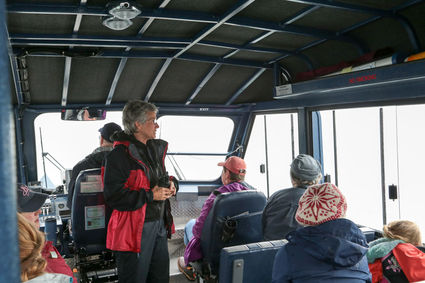What's behind the Steller sea lion decline? Pinniped expert presents recent research

Jessica Seevers / Submitted Photo
Marine mammal expert Kate Wynne from the Alaska Sea Grant Marine Advisory Program takes a group of Rainforest Festival participants out to spot pinnipeds–harbor seals and seal lions– near the LeConte Glacier Sept. 7. Wynne presented her research on the long-term decline of the Stellar sea lion population during the festival.
PETERSBURG – Marine mammal expert Kate Wynne presented at Rainforest Festival in Petersburg Sept. 6 on a topic that affects all coastal Alaskan communities: sea lions and harbor seals.
Wynne works with the Alaska Sea Grant Marine Advisory Program and studies pinnipeds, the classification for seals and sea lions, as well as other marine mammals like whales.
Most of the Steller sea lions in Alaska, those found north of Cape Suckling, are part of what is called the Western stock, Wynne said. This stock extends across to Russia and even into Japan.
According to Wynne, the Western stock has experienced a drastic population decline from the 1960s to the 1990s, since leveling off but not recovering in ways scientists had expected.
"And right about Cape Suckling, in the north middle part of the Gulf of Alaska, from there westward we saw the population from the 1960s do this nosedive...large mammals don't normally nose dive like that," Wynne said.
However the Eastern stock, including sea lions in Washington, Oregon and California, have seen steady growth of about four percent per year since the 1980s.
"To be honest we're not really sure but there were probably three or four things that were at play...We still really don't know what drives this population," she said of the Western stock population decline.
As part of her research with the Alaska Sea Grant Marine Advisory Program, Wynne, colleagues and volunteers have been studying sea lion scat and comparing it with that of harbor seals whose population has been increasing 4-6 percent a year.
Since sea lions and harbor seals occupy the same territories and prey on similar species of fish, studying their scat is helping unveil some of the dietary differences that might be associated with the population decline for sea lions and increase for seals.
"They're (sea lions) incredibly effective digesters, so all that comes out of there is a handful of little tiny bones, pieces, eyes, lenses, squid beaks, little tiny otoliths- ear bones from the fish. But they're identifiable," said Wynne.
They assess those bones to determine what species of fish are comprising the diet of each type of animal.
One-third of the scat samples for sea lions contained four main food groups: pollock, arrow tooth flounder, sand lance and Pacific cod.
Examining harbor seal scat revealed many of the same prey, but a distinct preference for sub-tidal species like sculpins, rock sole and greenlings, "the rock pile species that are around the haul outs," Wynne said.
Wynne also talked about some of the issues sea lions pose with commercial fishermen and in the local harbors.
An issue not unfamiliar to harbor users in many communities is sea lions taking up residence on floats, preventing their use by the intended users. Wynne said the animals also sometimes sink floats.
One solution to this problem used in Wynne's home-base Kodiak was keeping but relocating an old breakwater float when a new float was constructed. The sea lions had already staked their claim to the old float and were happy to continue taking up residency there leaving the new float free for its intended human users.
Another problem for coastal communities across the state is dealing with remnants from fish cleaning stations and people feeding sea lions.
Regarding fish cleaning stations, Wynne said, "Our solution in Kodiak was to create little dumpsters for the (fish) carcasses. Then these dumpsters are on wheels and they get carted away...and processed into fish meal."
Feeding sea lions is considered harassing the animals and is a federal offense, Wynne said. Campaigns ranging from signage in the harbor and verbal warnings for violators have been met with success in communities experiencing this problem.



Reader Comments(0)